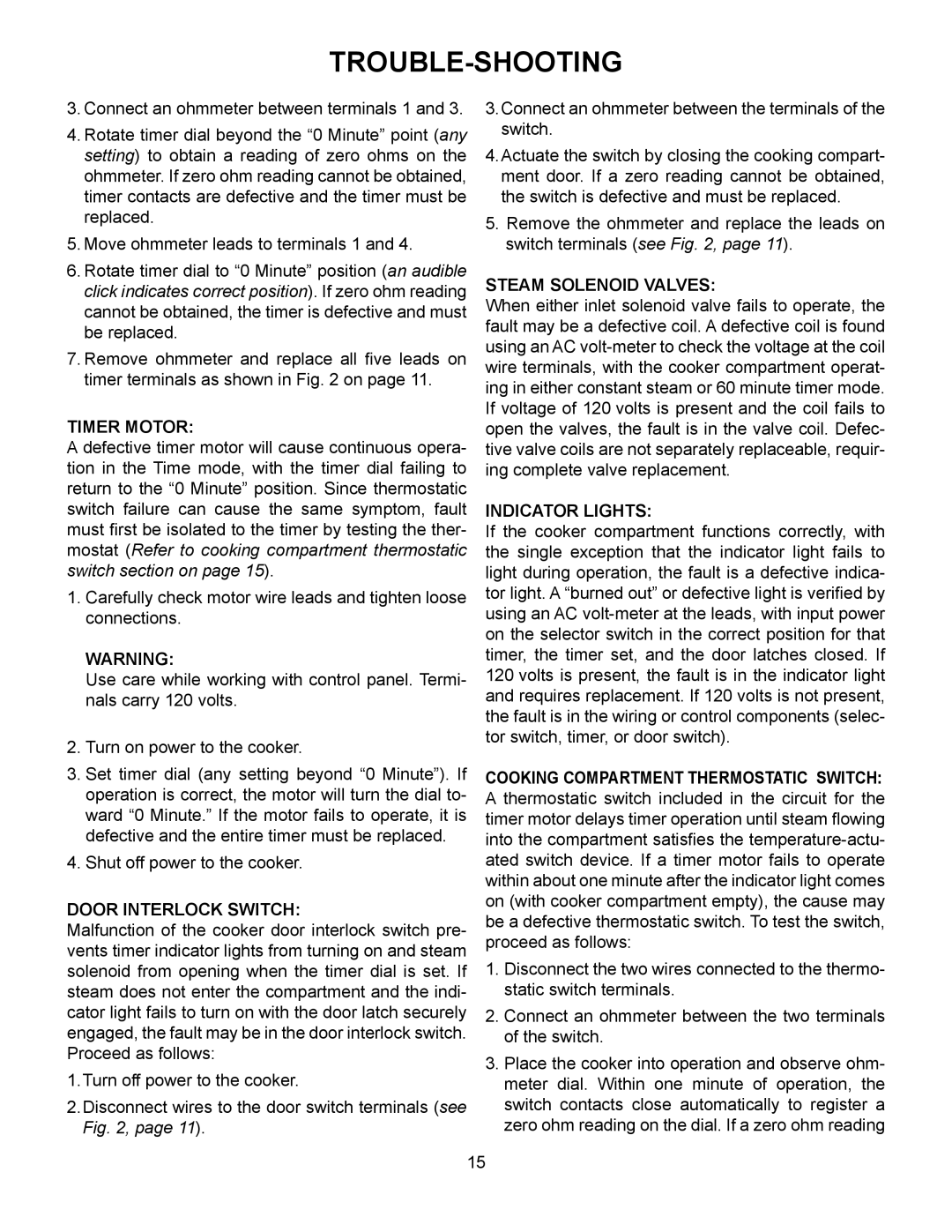TROUBLE-SHOOTING
3.Connect an ohmmeter between terminals 1 and 3.
4.Rotate timer dial beyond the “0 Minute” point (any setting) to obtain a reading of zero ohms on the ohmmeter. If zero ohm reading cannot be obtained, timer contacts are defective and the timer must be replaced.
5.Move ohmmeter leads to terminals 1 and 4.
6.Rotate timer dial to “0 Minute” position (an audible click indicates correct position). If zero ohm reading cannot be obtained, the timer is defective and must be replaced.
7.Remove ohmmeter and replace all five leads on timer terminals as shown in Fig. 2 on page 11.
TIMER MOTOR:
A defective timer motor will cause continuous opera- tion in the Time mode, with the timer dial failing to return to the “0 Minute” position. Since thermostatic switch failure can cause the same symptom, fault must first be isolated to the timer by testing the ther- mostat (Refer to cooking compartment thermostatic switch section on page 15).
1.Carefully check motor wire leads and tighten loose connections.
WARNING:
Use care while working with control panel. Termi- nals carry 120 volts.
2.Turn on power to the cooker.
3.Set timer dial (any setting beyond “0 Minute”). If operation is correct, the motor will turn the dial to- ward “0 Minute.” If the motor fails to operate, it is defective and the entire timer must be replaced.
4.Shut off power to the cooker.
DOOR INTERLOCK SWITCH:
Malfunction of the cooker door interlock switch pre- vents timer indicator lights from turning on and steam solenoid from opening when the timer dial is set. If steam does not enter the compartment and the indi- cator light fails to turn on with the door latch securely engaged, the fault may be in the door interlock switch. Proceed as follows:
1.Turn off power to the cooker.
2.Disconnect wires to the door switch terminals (see Fig. 2, page 11).
3.Connect an ohmmeter between the terminals of the switch.
4.Actuate the switch by closing the cooking compart- ment door. If a zero reading cannot be obtained, the switch is defective and must be replaced.
5.Remove the ohmmeter and replace the leads on switch terminals (see Fig. 2, page 11).
STEAM SOLENOID VALVES:
When either inlet solenoid valve fails to operate, the fault may be a defective coil. A defective coil is found using an AC
INDICATOR LIGHTS:
If the cooker compartment functions correctly, with the single exception that the indicator light fails to light during operation, the fault is a defective indica- tor light. A “burned out” or defective light is verified by using an AC
COOKING COMPARTMENT THERMOSTATIC SWITCH: A thermostatic switch included in the circuit for the timer motor delays timer operation until steam flowing into the compartment satisfies the
1.Disconnect the two wires connected to the thermo- static switch terminals.
2.Connect an ohmmeter between the two terminals of the switch.
3.Place the cooker into operation and observe ohm- meter dial. Within one minute of operation, the switch contacts close automatically to register a zero ohm reading on the dial. If a zero ohm reading
15
